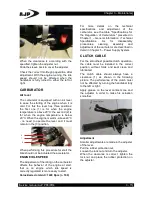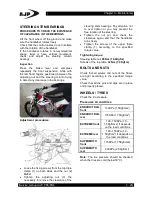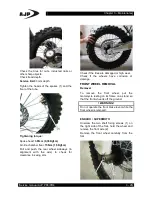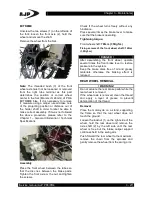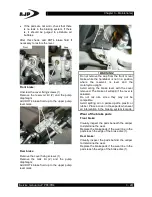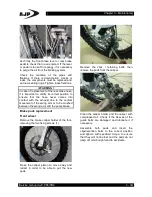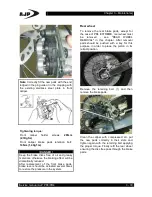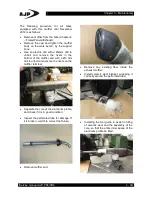
Chapter 3 – Maintenance
Service manual AJP PR3/PR4 3 - 28
Assembly
To assemble the rear wheel, should be
followed the procedure in reverse order,
taking care to put the brake disc between the
pads. Make sure that the wheel guides are
touching the adjusting screws (3) and they
both have the same adjustment. Tighten the
nut of the rear axle with the proper torque.
Check if the wheel turns freely. Press several
times the brake pedal to make sure that the
rear brake is operating.
Tightening torque:
Shaft nut of the rear wheel:
93N.m
(9,5Kgf.m)
! DANGER !
After assembling the rear wheel, actuate the
rear brake pedal until the system pressure is
restored.
Keep the discs free of oil and greasy
materials, otherwise the braking power is
drastically reduced.
Tighten the axle nut with the proper torque. A
loose wheel can lead to an unstable behavior
of the motorcycle.
BRAKE SYSTEM
Brake discs
Due to wear, the thickness of the brake discs
in the contact area (1) with the pads
decreases. In its thinnest point (A), the
difference in thickness with respect to the
nominal thickness may not be larger than 0.5
mm. Measure the nominal thickness in the
area (B) outside the contact area and check
in several points of the disc.
! DANGER !
For safety, the brake discs must be replaced
as soon as they reach their wear limit (3mm
thick).
Brake fluid reservoirs
The brake fluid reservoirs are designed so
that even with worn pads is not necessary to
top up the level. If the fluid level becomes
lower than the minimum level it means that
the brake system has a leak or that the pads
are worn out.
Brake fluid check
Recommended brake fluid:
ENI Brake Fluid DOT 4 (SAE J1703,
FMVSS116)
Check the oil level of the reservoirs (1) of the
front and rear brake.
If the level is near the lower mark, check the
brake pads wear:
If the pads are worn, replace it;


